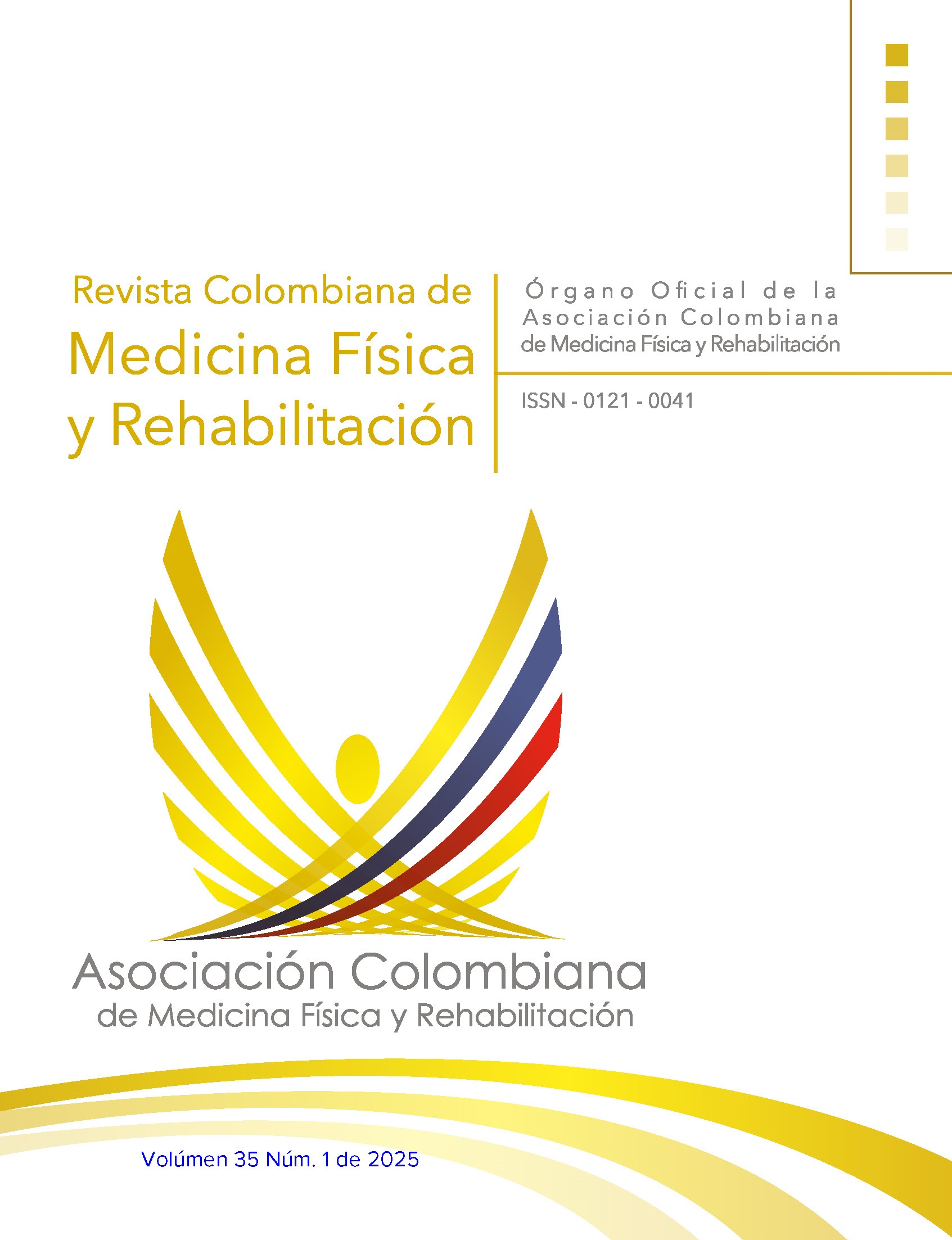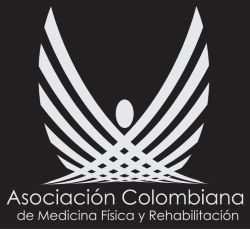Prevalence of painful shoulder in patients with central nervous system lesions who participated in an interdisciplinary rehabilitation process
DOI:
https://doi.org/10.28957/rcmfr.475Keywords:
Shoulder pain, prevalence, central nervous system diseases, rehabilitationAbstract
Introduction. Central nervous system (CNS) lesions often cause sequelae that impact the quality of life of patients, with painful shoulder standing out as a frequent complication. This condition affects between 5% and 84% of patients with cerebrovascular accident (CVA) and is common in those with spinal cord injury, head trauma, multiple sclerosis, among others. Despite its high prevalence, shoulder pain has been poorly studied in some of these diseases, and information on its prevalence in Colombia is scarce.
Objectives. To estimate the prevalence of painful shoulders in patient with CNS lesions who participate in the interdisciplinary rehabilitation program of the Clínica Universidad de la Sabana, characterize the population, identify the possible factors associated to the development of this condition and describe the treatments used.
Methods. Cross-sectional study conducted with adult patients with SNC lesions who ended the PIR® between the years 2015 and 2023. The development of painful shoulder was taken as the outcome variable of the study. The sample was divided into two groups (presence or not of painful shoulder) and the differences between both groups were evaluated searching possible associated factors; the Chi-square test was used for the qualitative variables, and Student T or Mann-Whitney U test for the quantitative variables depending on their distribution. A level of significance of p<0.05 was developed.
Results. Of 363 patients included, 46.3% developed painful shoulder, being more prevalent in patients with ischemic CVA (36.3%). The following conditions are identified as possible factors associated to painful shoulder: motor and sensory affection, spasticity, glenohumeral subluxation and rotator cuff syndrome. The therapies most often used were gymnastics, occupational therapy, electric stimulation, neuromodulators and opioids.
Conclusion. Painful shoulder is a common condition in patients with SNC lesions. An interdisciplinary approach and early rehabilitation can optimize the clinical and functional outcomes.
References
1. Anwer S, Alghadir A. Incidence, prevalence, and risk factors of hemiplegic shoulder pain: A systematic review. Int J Environ Res Public Health. 2020;17(14):4962. Disponible en: https://doi.org/10.3390/ijerph17144962.
2. Kalichman L, Ratmansky M. Underlying pathology and associated factors of hemiplegic shoulder pain. Am J Phys Med Rehabil. 2011;90(9):768-80. Disponible en: https://doi.org/10.1097/PHM.0b013e318214e976.
3. Azadvari M, Emami-Razavi SZ, Tavasol T, Rakhshan A. Prevalence of Shoulder Pain in Spinal Cord Injury Patients Referring to the Brain and Spinal Cord Injury Research Center of Tehran University of Medical Sciences. Arch Neurosci. 2019;7(1):e96150. Disponible en: https://doi.org/10.5812/ans.96150.
4. Manara JR, Taylor J, Nixon M. Management of shoulder pain after a cerebrovascular accident or traumatic brain injury. J Shoulder Elbow Surg. 2015;24(5):823-9. Disponible en: https://doi.org/10.1016/j.jse.2014.12.003.
5. ShayestehAzar M, Kariminasab MH, Saravi MS, Abedini M, Fazli M, Hashemi SA, et al. A Survey of Severity and Distribution of Musculoskeletal Pain in Multiple Sclerosis Patients; a Cross-Sectional Study. Arch Bone Jt Surg. 2015;3(2):114-8. Disponible en: https://doi.org/10.22038/abjs.2015.3939.
6. Rosner J, de Andrade DC, Davis KD, Gustin SM, Kramer JLK, Seal RP, et al. Central neuropathic pain. Nat Rev Dis Primers. 2023;9(1):73. Disponible en: https://doi.org/10.1038/s41572-023-00484-9.
7. Rodríguez-Serrezuela R, Torres-Quezada M, Hernández-Zayas M, Montoya-Pedrón A, Milanés-Hermosilla D, Sagaró-Zamora R. Robotic therapy for the hemiplegic shoulder pain: a pilot study. J Neuroeng Rehabil. 2020;17(1):54. Disponible en: https://doi.org/10.1186/s12984-020-00674-6.
8. Murie-Fernández M, Carmona-Iragui M, Gnanakumar V, Meyer M, Foley N, Teasell R. Hombro doloroso hemipléjico en pacientes con ictus: causas y manejo. Neurología. 2012;27(4):234-44. Disponible en: https://doi.org/10.1016/j.nrl.2011.02.010.
9. Zhang Q, Chen D, Shen Y, Bian M, Wang P, Li J. Incidence and Prevalence of Poststroke Shoulder Pain Among Different Regions of the World: A Systematic Review and Meta-Analysis. Front Neurol. 2021;12:724281. Disponible en: https://doi.org/10.3389/fneur.2021.724281.
10. Rekand T, Hagen EM, Grønning M. Chronic pain following spinal cord injury. Tidsskr Nor Legeforen. 2012;132(8):974-9. Disponible en: https://doi.org/10.4045/tidsskr.11.0794.
11. Kumar P, Fernando C, Mendoza D, Shah R. Risk and associated factors for hemiplegic shoulder pain in people with stroke: a systematic literature review. Phys Ther Rev. 2022;27(3):191-204. Disponible en: https://doi.org/10.1080/10833196.2021.2019369.
12. Li Y, Yang S, Cui L, Bao Y, Gu L, Pan H, et al. Prevalence, risk factor and outcome in middle-aged and elderly population affected by hemiplegic shoulder pain: An observational study. Front Neurol. 2023;13:1041263. Disponible en: https://doi.org/10.3389/fneur.2022.1041263.
13. Rivera-Rujana DM, Tovar-Ruíz LA, Jacome-Velasco SJ, Villaquirán-Hurtado AF. Descripción de la discapacidad y sus determinantes en personas con hemiparesia/hemiplejia del suroccidente de Colombia. Hacia promoc. Salud. 2022;27(2):71-87. Disponible en: https://doi.org/10.17151/hpsal.2022.27.2.6.
14. Clínica Universidad de la Sabana. Proceso Interdisciplinario de Rehabilitación PIR. Chía: Clínica Universidad de la Sabana; [citado abril 24 de 2025]. Disponible en: https://www.clinicaunisabana.edu.co/proceso-interdisciplinario-de-rehabilitacion-pir.
15. Sciascia AD. Rehabilitation of the painful shoulder. J Shoulder Elbow Surg. 2024;33(2):494-506. Disponible en: https://doi.org/10.1016/j.jse.2023.07.013.
16. Zeilig G, Rivel M, Weingarden H, Gaidoukov E, Defrin R. Hemiplegic shoulder pain: Evidence of a neuropathic origin. Pain. 2013;154(2):263-71. Disponible en: https://doi.org/10.1016/j.pain.2012.10.026.
17. Salazar-Lengua CE, Barrios-García CC, García-Gutierrez LM, Jaimes-Fernández DA. Adherencia terapéutica y factores relacionados a un grupo de pacientes sometidos a intervenciones de un proceso de rehabilitación. Rev Col Med Fis Rehabil. 2024;34(1):e423. Disponible en: http://doi.org/10.28957/rcmfr.423.
18. Toro-Hernández ML, Mondragón-Barrera A, Múnera-Orozco S, Villa-Torres L, Camelo-Castillo W. Experiences with rehabilitation and impact on community participation among adults with physical disability in Colombia: perspectives from stakeholders using a community based research approach. Int J Equity Health. 2019;18(1):18. Disponible en: https://doi.org/10.1186/s12939-019-0923-4.
19. Jia F, Zhu XR, Kong LY, Fan JC, Zhu ZJ, Lin LZ, et al. Stiffness changes in internal rotation muscles of the shoulder and its influence on hemiplegic shoulder pain. Front. Neurol. 2023;14:1195915. Disponible en: https://doi.org/10.3389/fneur.2023.1195915.
20. Paolucci S, Iosa M, Toni D, Barbanti P, Bovi P, Cavallini A, et al. Prevalence and Time Course of Post Stroke Pain: A Multicenter Prospective Hospital-Based Study. Pain Medicine. 2016;17(85):924-30. Disponible en: https://doi.org/10.1093/pm/pnv019.
21. Winstein CJ, Stein J, Arena R, Bates B, Cherney LR, Cramer SC, et al. Guidelines for Adult Stroke Rehabilitation and Recovery: A Guideline for Healthcare Professionals From the American Heart Association/American Stroke Association. Stroke. 2016;47(6):e98-169. Disponible en: https://doi.org/10.1161/STR.0000000000000098.
22. Van Straaten MG, Cloud BA, Zhao KD, Fortune E, Morrow MMB. Maintaining Shoulder Health After Spinal Cord Injury: A Guide to Understanding Treatments for Shoulder Pain. Arch Phys Med Rehabil. 2017;98(5):1061-3. Disponible en: https://doi.org/10.1016/j.apmr.2016.10.005.
23. Hogaboom NS, Worobey LA, Boninger ML. Transfer Technique Is Associated With Shoulder Pain and Pathology in People With Spinal Cord Injury: A Cross-Sectional Investigation. Arch Phys Med Rehabil. 2016;97(10):1770-6. Disponible en: https://doi.org/10.1016/j.apmr.2016.03.026.
24. Yi Y, Shim JS, Kim K, Baek SR, Jung SH, Kim W, et al. Prevalence of the rotator cuff tear increases with weakness in hemiplegic shoulder. Ann Rehabil Med. 2013;37(4):471-8. Disponible en: http://doi.org/10.5535/arm.2013.37.4.471.
25. Beom J, Jang HJ, Han TR, Oh BM, Paik NJ, Yang EJ, et al. Fatty replacement of rotator cuff in brain-injured patients is associated with hemiplegic arm function, but not with tendon tear: A multicenter study. NeuroRehabilitation. 2015;37(2):213-9. Disponible en: https://doi.org/10.3233/NRE-151254.
26. Finnerup NB, Attal N, Haroutounian S, McNicol E, Baron R, Dworkin RH, et al. Pharmacotherapy for neuropathic pain in adults: a systematic review and meta-analysis. Lancet Neurol. 2015;14(2):162-73. Disponible en: https://doi.org/10.1016/S1474-4422(14)70251-0.
27. de Sire A, Moggio L, Demeco A, Fortunato F, Spano R, Aiello V, et al. Efficacy of rehabilitative techniques in reducing hemiplegic shoulder pain in stroke: systematic review and meta-analysis. Ann Phys Rehabil Med. 2022;65(5):101602. Disponible en: https://doi.org/10.1016/j.rehab.2021.101602.
28. Mulroy SJ, Hafdahl L, Dyson-Hudson T. A Primary Care Provider’s Guide to Shoulder Pain After Spinal Cord Injury. Top Spinal Cord Inj Rehabil. 2020;26(3):186-96. Disponible en: https://doi.org/10.46292/sci2603-186.
29. Deng P, Zhao Z, Zhang S, Xiao T, Li Y. Effect of kinesio taping on hemiplegic shoulder pain: A systematic review and meta-analysis of randomized controlled trials. Clin Rehabil. 2021;35(3):317-31. Disponible en: https://doi.org/10.1177/0269215520964950.
30. World Medical Association (WMA). WMA Declaration of Helsinki – Ethical principles for medical research involving human subjects. Fortaleza: 64th WMA General Assembly; 2013 [citado mayo 5 de 2025]. Disponible en: https://www.wma.net/es/policies-post/declaracion-de-helsinki-de-la-amm-principios-eticos-para-las-investigaciones-medicas-en-seres-humanos/.
31. Colombia. Ministerio de Salud. Resolución 8430 de 1993 (octubre 4): Por la cual se establecen las normas científicas, técnicas y administrativas para la investigación en salud. Bogotá D.C.; octubre 4 de 1993 [citado mayo 5 de 2025]. Disponible en : https://www.minsalud.gov.co/sites/rid/lists/bibliote-cadigital/ride/de/dij/resolucion-8430-de-1993.pd
How to Cite
Downloads
Downloads
Published
Issue
Section
License
Copyright (c) 2025 Revista Colombiana de Medicina Física y Rehabilitación

This work is licensed under a Creative Commons Attribution-NonCommercial-NoDerivatives 4.0 International License.

| Article metrics | |
|---|---|
| Abstract views | |
| Galley vies | |
| PDF Views | |
| HTML views | |
| Other views | |


